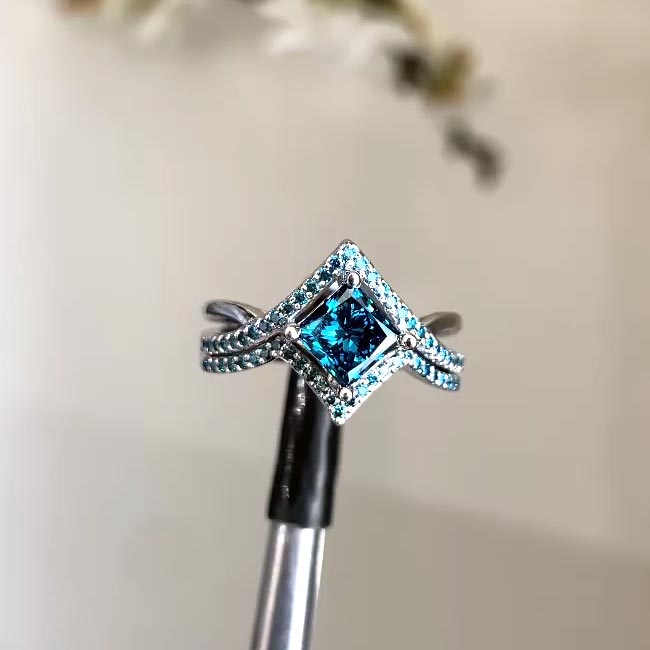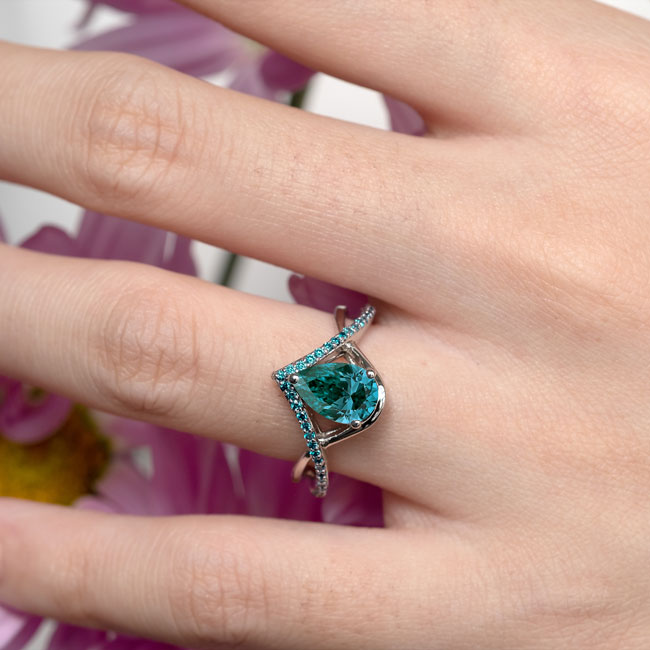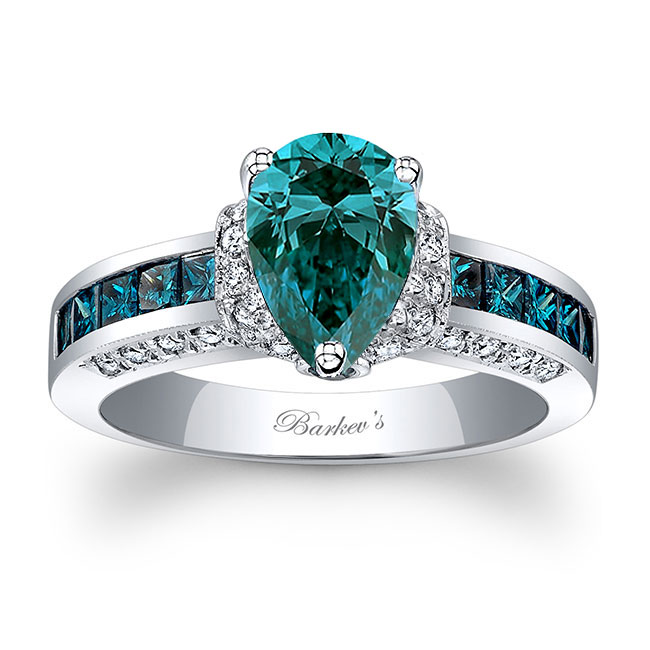Diamonds are available in different colors; some are extremely expensive and very rare. These colors include blue, green, pink and yellow as the most popular choices. Celebrities are famous for wearing custom made colored diamond jewelry, for example Jennifer Lopez’s pink diamond engagement ring.
Blue diamonds have seen a resurgence in popularity in the last few years providing those who seek a unique look with a brilliant sparkle and a distinctive color.
The word fancy refers to diamonds that contain other colors than the typical white diamond. Fancy color diamonds are graded differently than white diamonds. The last grade on the color grading scale for white diamonds is a “Z”, which denotes a slight color visible to the naked eye. When the diamond exhibits a more intense, noticeable shade of color, they are described as fancy.
Natural Blue Diamonds: An Inside Look
Natural blue diamonds can range from very light to high intensity blue. The intense shades these diamonds display is referred to as ocean blue, reminiscent of the deep, beautiful ocean exhibiting a rich royal shade.
Natural blue diamonds are genuine diamonds that form under the earth’s lower mantle over several years, undergoing the same formation process as white diamonds. The color these diamonds feature comes from traces of boron, which contaminates the crystalline structure.
According to GIA, the natural color of diamonds may also be a result of radiation or exposure to hydrogen. When a natural blue diamond is exposed to radiation, it may result in a green-blue color, or when it is exposed to hydrogen, it may end up showcasing gray-violet or gray tones.
Blue diamonds, like white diamonds, have the same tetrahedral cubic crystal structure, rate 10 on the Mohs hardness scale and are sourced from India, South Africa, Brazil and Indonesia.

Treated Blue Diamonds: A Vibrant Alternative
Natural blue diamonds can run 10x times the cost of treated blue diamonds per carat, making them significantly more costly than the treated version. Treated diamonds provide the perfect alternative for those who love the incredible color of the natural variety without the hefty price tag.
Treated blue diamonds are natural diamonds that have undergone a process called “Irradiation” that changes their body color to blue, black, yellow and others. Treated diamonds are also referred to as enhanced diamonds or treated diamonds.
Barkev’s features a wide range of treated fancy colored diamonds set as side stones or center stones on various engagement rings, wedding bands and fine jewelry.
Frequently Asked Questions About Blue Diamonds:
What is a blue diamond engagement ring?
Blue refers to a fancy colored diamond or a diamond that exhibits a blue color rather than white. Blue diamond engagement rings are one of the most popular rings on the market for those who seek an alternative to the white diamond but still want the prestige that a diamond offers.
A blue diamond engagement ring can have a blue diamond as its main center stone or it could have smaller blue diamonds on the sides of the ring or it could exhibit both for a truly stunning look.
Is a blue diamond better than a white diamond?
The answer is quite subjective. Fancy (colored) diamonds are rarer as mentioned previously, and can be considerably more expensive than a white diamond when looking at price per carat. If a person leans more towards the color blue, then a fancy vivid blue diamond might suite their taste more than a typical white diamond.

Are blue diamonds good?
If by good you mean worth something, then the answer is yes! Ultra-light fancy color diamonds however are not as valuable as fancy dark diamonds. So, make sure to select a rich deep colored blue stone to get as much value out of the stone possible.
Are treated diamonds real diamonds?
Yes, treated diamonds are genuine diamonds that have been enhanced/treated to change their color. They belong to a subcategory of diamonds known as fancy colors.
How can you tell if a blue diamond is real?
Only a diamond expert can tell the difference between a real blue diamond and a fake. When buying a natural blue diamond, always make sure it comes with a certificate indicating its authenticity. Usually, a natural stone will be extremely expensive when compared to a treated one.
When buying a treated blue diamond, you don’t need to worry about a certificate, however you still need to make sure it’s a diamond in the first place. In general, a real blue diamond whether it’s natural or treated will always exhibit all the qualities of a regular diamond with the addition of a beautiful color.

Does treating a diamond damage it?
No, irradiation permanently changes the color of the diamond without damaging it at all. Diamonds are one of the hardest, most durable minerals on earth and damaging one is not an easy thing to do.
Are treated diamonds the same as lab-created diamonds?
No, lab-created diamonds are made synthetically in a laboratory. Treated diamonds on the other hand are real natural diamonds from the earth that have undergone a treatment process to change their color.
Are treated diamonds a good choice for an engagement ring?
Yes, treated diamonds are an elegant and sophisticated choice for an engagement or anniversary ring. If you want to wear something unique, high-quality and colorful, then a treated blue diamond engagement ring is the right choice for you.

Are color-enhanced diamond rings tacky?
Treated diamonds are not tacky, but offer a beautiful alternative to the classic diamond engagement ring. Treated diamonds provide a rich, intense vibrancy that may be rarer to find in nature and incredibly expensive.
Enhanced diamonds set into noble metals with white diamonds or other treated diamonds create an ambience filled with noteworthy color, sparkle, and prestige. You’ll always get noticed with a fancy diamond engagement ring.
Are blue diamonds sparkly?
Yes, blue diamonds whether they are natural or treated will always sparkle with an incredible fire. If you are seeking a rich, vibrant ocean blue shade, consider a fancy diamond for your engagement ring.
Looking to buy a blue diamond engagement ring? We are here to help!


